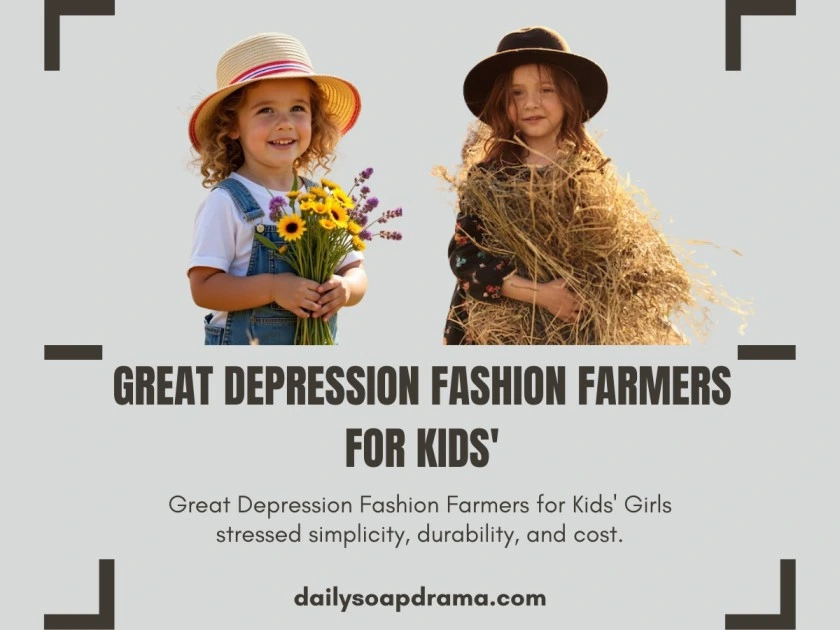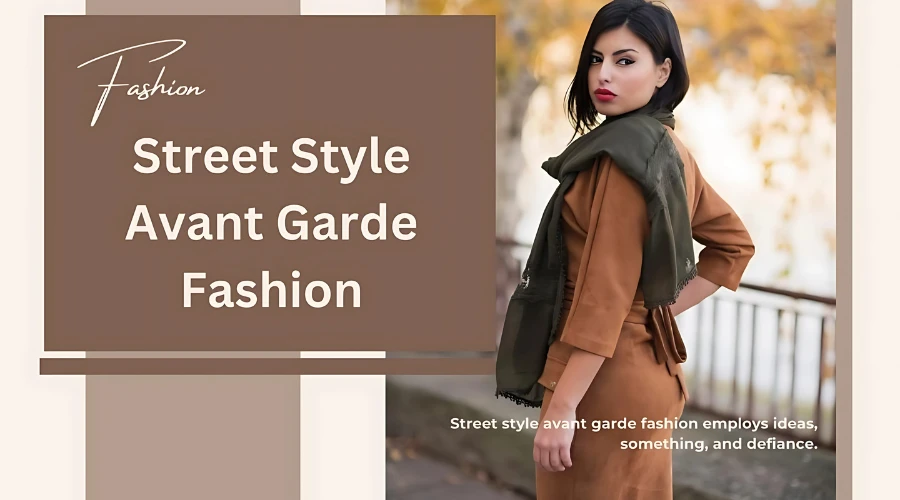From 1929 until the late 1930s, the Great Depression affected all Americans. Extreme poverty, unemployment, and misery plagued families. Despite these obstacles, fashion evolved in distinctive ways, showing the era's drive and genius. A realistic reflection of what they faced, Great Depression Fashion Farmers for Kids' Girls stressed simplicity, durability, and cost.
During the Great Depression, youngsters and girls dressed differently than now. This article will examine how Great Depression fashion for farmers' kid's girls changed to match the times' demands, revealing the materials, colors, and practical designs of the time.
We will also study how socio-economic factors affected farming families' apparel and how parents adapted and repurposed items to outfit their children well in hard times. Farm children wore plain, sturdy attire during the Great Depression.
Understanding the Great Depression
What Was the Great Depression?

The Great Depression ran from 1929 to the late 1930s. Many people lost their jobs and struggled financially. Farmers were struck hard by the economy and farm failures. Farmers dressed in style and almost despite the obstacles.
Why Fashion Matters
You may question why we care about Great Depression fashion. Fashion reflects culture and history. The way farmers dressed tells us about their life and struggles. Fun and enjoyable, it lets us connect with the past!
Read also: Fashion Nova vs Zara: Size Chart Comparison
The Basics Great Depression Fashion Farmers for Kids' Girls
Simple Farm Outfits from the Great Depression
Farmers wanted durable, practical, and comfortable. Outfits often included:
- Overalls: They were popular among farmers. The robust fabric made them ideal for fieldwork.
- Plain Shirts: Simple button-up shirts were common among farmers. Cotton or wool shirts were easy to launder.
- Dresses for Women: Farmwork-friendly long gowns were worn by women. Simple cotton patterns were common.
Fun Activities: Learning about Great Depression Fashion
Create Your Own Farm Outfit
Now that you know about Great Depression fashion for farmers, why not try making your own farm outfit? Here are some ideas:
- Find Old Clothes: Search your closet for gently used items you could use again.
- Use Fabric Scraps: You may make a layered piece using fabric waste.
- Accessorize: Don't overlook adding boots or a hat to finish your outfit!
History Day at School
You may also show your friends what you have found! Here are some approaches for doing that:
- Poster Presentation: Create a poster showing different styles of clothing from the Great Depression.
- Fashion Show: Organize a mini fashion show at school where kids can dress up in 1930s-inspired outfits.
Read also: High Fashion Street Style
The Influence of Rural Life on Farmers’ Kids Girls’ Fashion
Kids and girls' wardrobe choices were influenced by agricultural families' physical demands and survival concerns. Durable, basic clothing was needed for outdoor work, chores, and long hours in fields or with farm animals. Long-lasting garments have to be easy to maintain and mend.
1. Usability and Comfort
Practicality dominates rural girls' dress. Rural children work in fields, herd animals, and do housework, so their clothes must be sturdy and comfortable. Denim, cotton, and strong wool are utilized because they are robust and simple to clean. Flexibility and comfort make overalls, loose shirts, and pants popular.
2. Nature Connection
Farmers' kids' attire reflects their rural upbringing and closeness to nature. Rural females use earthy colors like browns, greens, and tans to match their surroundings. Girls may wear dresses, skirts, and blouses with floral and animal designs because they live in the country.
3. Cultural and Traditional Influences
Families with farmers' children frequently cherish tradition and culture. Some families follow generational clothing trends, which might affect how they dress. Girls may wear dresses or skirts that represent local or regional fashion. Crocheted sweaters, hand-sewn skirts, and knitted headgear may be preferred in rural settings.
4. Practicality and Gender Roles
Many rural societies' gender roles affect children's clothes. Girls wear dresses and skirts, but they often alter them for practicality. To work comfortably, a girl can wear a sturdy dress or skirt with leggings or pants. Country girls' dress reflects their anticipated blend of elegance and practicality.
5. Simplicity over trend
Country attire is simpler than city fashion. Farmgirls wear classic, useful clothes instead than trendy ones. This simplicity comes from country life's slower pace, where utility trumps fashion. Daughters frequently wear hand-me-downs or recycled clothes to optimize their use.
6. DIY and Handmade Culture
Self-reliance and resourcefulness are common in rural settings. Farmers' children may wear hand-knitted scarves or dresses created by their mothers or grandmothers. DIY clothes represents rural living and fosters innovation and customisation. Girls can also customize their clothes to fit their requirements or utilize fabric leftovers, making rural fashion even more distinctive.
7. Seasonality Inspiration
Seasons also influence rural girls' dress. They wear woolen sweaters, coats, and boots in winter and light cotton skirts or shirts with shorts in summer. Rural life's seasonality and concentration on farming inspire weather-appropriate dress.
8. Impact of Rural Icons and Celebrities
Rural celebrities, country bands, and agricultural personalities can inspire rural fashion. Farmers' kids may admire and copy these folks' fashions. Cowboy boots, plaid shirts, and denim are popular in rural areas because of country music singers.
Read also: Trending youth fashion in Western
Fabrics and Materials for Farmers’ Kids Girls
In the Great Depression, households reused and repurposed anything they could. Farming households have minimal means for apparel due to the economic crisis.
Kids' girls' clothes was made from cheap fabrics. The most frequent textiles for children's apparel during the Depression were:
- Cotton: This cloth was the daily choice. Cost-effective, sturdy, and simple to clean cotton was ideal for working youngsters.
- Wool: Wool, especially in winter, was another staple. Though recycled from discarded clothes, it was warm and durable.
- Denim: Overalls and skirts were made from denim, especially for farm girls who needed tough attire for the hard life on the farm.
- Flannel: Warm shirts and skirts were made from flannel. Soft and perfect for winter, it kept youngsters warm.
DIY Fashion and Upcycling During the Great Depression

Farmers' kids and girls wore innovative and frugal attire throughout the Great Depression. With limited means, many parents handcrafted their children's clothes. Upcycling outdated textiles, hand-me-downs, and scraps was common.
Cutting and sewing a girl's old dress can make a new one. Old shirts may become skirts, and adult clothes can suit kids. This may seem like a simple requirement, but families would experiment with patchwork or hand-stitching new parts.
Accessories for Farmers’ Kids Girls in the 1930s
Although accessories were less prominent in Great Depression fashion for farmers' children and girls, they nonetheless played a part in customizing clothes. Scarves, hats, and handcrafted jewelry were utilized to dress up plain clothing.
1. Bandanas, headscarves
Rural girls wore headscarves in the 1930s. While laboring in the fields or doing agricultural chores, these cotton or other lightweight scarves kept hair out of the face. For practical and fashion reasons, bandanas were knotted over the head or neck. These embellishments gave rural girls' clothing a rustic look and purpose.
2. Knitted or handmade hats
Knitted or crocheted caps were necessary in winter. Parents, grandmothers, and other family members fashioned these caps to keep warm while working outdoors. The hats were basic, made of wool or other warm materials, and might have plain knit or colorful designs. Some hats have pom-poms or crocheted flowers to add individuality.
3. Apron
Rural girls, especially those who helped their moms cook or clean, needed aprons. Cotton, linen, and other sturdy textiles were used to make handcrafted aprons. Wearing them over dresses or skirts protected them from dirt, stains, and wear. Aprons were useful for carrying tools, herbs, and vegetables on farms. Simple pockets added flair and function to some aprons.
4. Boots and Shoes
Girls required strong shoes or boots for lengthy walks, fieldwork, and animal care. Leather or rubber boots were popular in rural regions because they could tolerate dirt and water. In winter, these boots were worn with woolen stockings. Girls may wear sensible leather shoes with buckles or ribbons for church or dressier events. Canvas sandals or shoes were popular in warmer seasons.
5. Belted waistbands
Girls in the 1930s wore dresses or skirts with belted waistbands for style and function. These belts supported skirts and dresses when running, leaping, or doing field tasks. Simple leather or fabric straps might be knotted or buckled. Despite their practicality, belts gave girls' outfits elegance and form.
6. Pinafores
Despite not being an accessory, the pinafore—an apron-like dress—was fashionable and functional over dresses. In the 1930s, girls wore cotton or denim pinafores for housework and play. Pinafores with lace trimmings or tiny needlework were protective and beautiful.
7. Bags, Pouches
Rural girls carried little purses or pouches for cash, herbs, and tools. These bags were created from cloth, leather, or other home-available materials. Girls may have utilized baskets for eggs, fruits, and veggies or simple cloth bags. These attachments were useful for organizing minor objects throughout daily duties.
8. Ribbons, Hair Accessories
While simpler than metropolitan fashion, rural females used ribbons and hair ornaments. These cotton or satin attachments tied hair into braids or ponytails. Ribbons were put in the hair to decorate plain clothing. These are discreet but beautiful accessories that can be simple or decorated with little bows.
9. Socks, stockings
In winter, socks and stockings were essential. Girls with dresses and skirts used woolen or cotton socks for warmth. Girls wore knee-high socks with skirts or dresses and thicker wool socks under boots in the 1930s. Dressy events might include cotton or silk stockings.
The Lasting Impact of Great Depression Fashion on Today Styles
The Great Depression fashion for farmers' children and girls shaped families and future generations. The sustainable fashion movement would incorporate upcycling and repurposing, among other inventive clothing-making methods.
Modern children's fashion still emphasizes basic, durable, useful, and comfortable apparel. Vintage clothing lines and collections also reflect Depression-era style's influence on 1930s fashion. Modern sustainable fashion fans like minimalism and clothes as a need.
Conclusion: Great Depression Fashion Farmers for Kids' Girls
In conclusion, Great Depression Fashion Farmers for Kids' Girls was more than just clothes; it was a reflection of hard work, creativity, and resilience. Through this exploration, you can see that even in tough times, people found ways to express themselves through their clothing.Remember, fashion is not just about what you wear; it’s about the stories behind those clothes. So, the next time you put on a simple outfit, think of the farmers from the Great Depression and the strength they showed. Let their spirit inspire you to be creative and resourceful in your own life!
FaQs Great Depression Fashion Farmers for Kids' Girls
What did children wear during the Great Depression?
Fashion. 1930s: Poor families couldn't afford much for their children, so they wore secondhand clothing and walked barefoot. T-shirts and overalls were worn by most middle-class lads and blouses and simple skirts by girls. Both would have one pair of shoes and a special occasion dress.
How was fashion affected by the Great Depression?
The Great Depression shaped society and fashion. Less free-spirited than in the Roaring Twenties, fashions grew more conservative. A touch of grace that would create history emerged from this new period.
How did girls dress in the 1930s?
Children's fashion in the 1930s resembled the 1920s. Girls' dresses returned to the natural waist like womenswear. Dresses were made of cotton and muslin with embroidery, piping, and frills.








